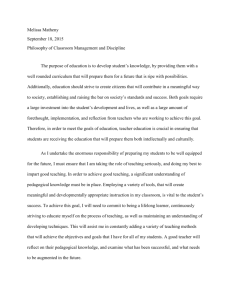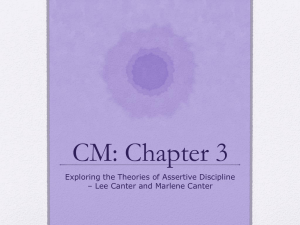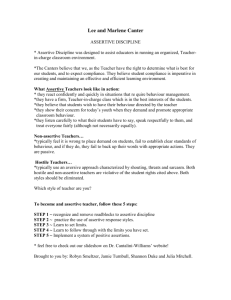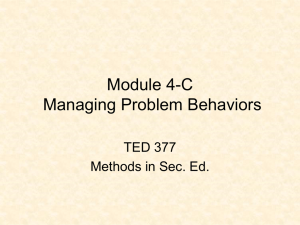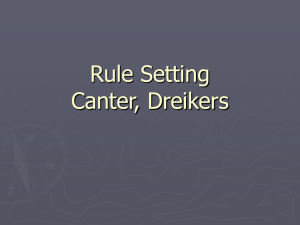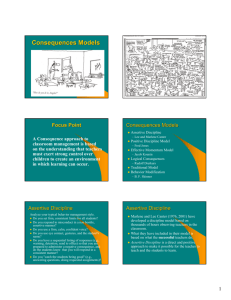Shyno-Research Paper-Assertive Discipline
advertisement
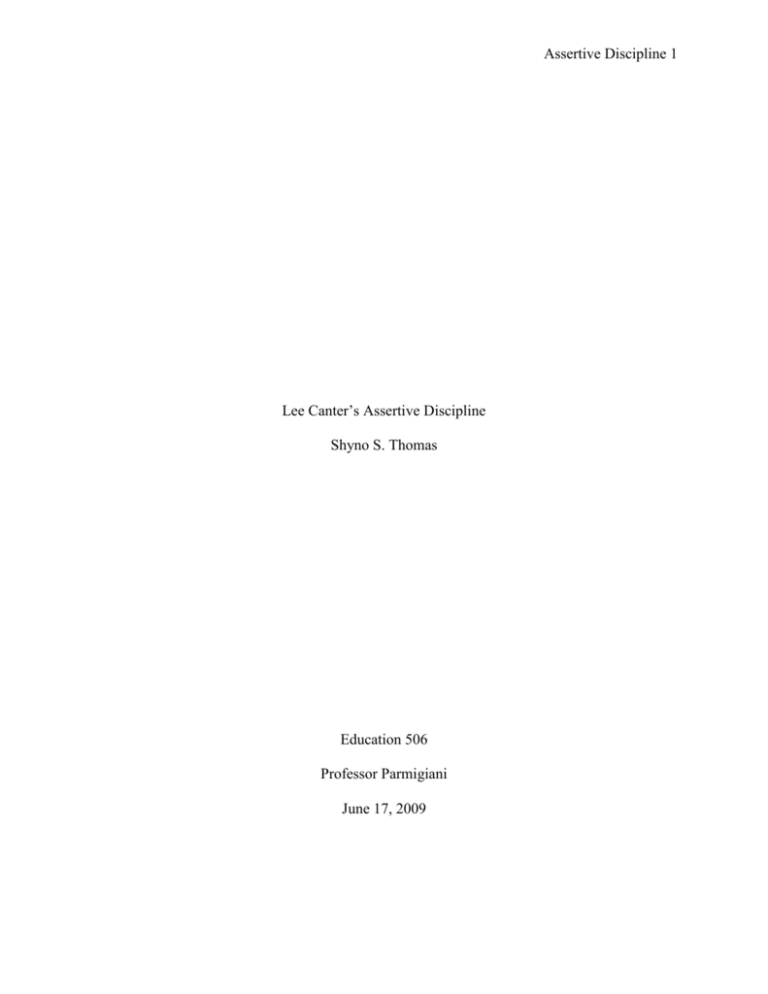
Assertive Discipline 1 Lee Canter’s Assertive Discipline Shyno S. Thomas Education 506 Professor Parmigiani June 17, 2009 Assertive Discipline 2 Lee Canter’s Assertive Discipline Schools today are serving children from diverse backgrounds. This includes children from dysfunctional homes, children living in poverty, children of teenage parents and children with special needs. Schools are confronted with various issues from substance abuse to gang recruitment to violence. The image of a teacher imparting instruction amidst a group of welladjusted students is a thing of the past. It is imperative that in this changing educational climate, schools identify programs that create an environment conducive to learning -- an environment that is safe for the well-being of the students and the teachers in the school and the classroom. Classroom management involves effective discipline, motivating students, being prepared for class and providing a safe, structured environment. Today’s schools use a variety of approaches to classroom management. One model of this approach is called assertive discipline, which was developed in 1976 by Lee and Marlene Canter. According to Lee and Marlene Canter (as cited by Dr. McIntyre), “Assertive discipline is a structured systematic approach designed to assist educators in running an organized, teacherin-charge classroom environment” (2005, para .1). According to the Canters, few schools provided training in behavior management. This prompted them to address the issue of classroom management by providing strategies to establish a safe environment conducive to learning. Canter & Canter (2001) advocate “supportive feedback” and “corrective actions.” Moore (2009) cites the Canters, who state that “assertive teachers do not tolerate improper behavior that interrupts learning” (p. 367). The teacher sets the rules for behavior early in the year. Students receive positive consequences such as free time and privileges for appropriate behavior and negative consequences such as detention or a visit to the principal for inappropriate behavior. Dr. McIntyre (2005, para. 3) further cites the Canters who state that Assertive Discipline 3 “assertive teachers react quickly and confidently in situations that require behavior management.” It is further stated that the Canters believe that this approach is more democratic as opposed to authoritarian. Teachers do not see their students as their enemies. They do not sneer or scoff at them, but react in a timely and consistent manner. Canter and Canter (2002) emphasize that it is important to use a proactive approach instead of a reactive approach. In a proactive approach, the teacher develops a systematic discipline plan, while in a reactive approach, the teacher reacts emotionally to provocation. They also suggest establishing a discipline hierarchy in the management plan. They insist that rules should be implemented firmly and consistently. The Canters suggest that it is important to focus on students who are complying with your rules with a “behavioral narration.” This narration reinforces positive behavior, teaches responsible behavior and reminds those who are not complying with the rules to follow a role model. They further state that it is also important to use one’s judgment in some situations, such as when a student is usually well behaved but suddenly appears disruptive for no reason. The Canters suggest that instead of using a corrective action, it would be more appropriate to sit down and talk to the student to find out what is wrong. Dr. McIntyre (2005) again cites the Canters, who emphasize that it is important to respond quickly to a desired behavior and, in some instances, to reinforce without actually embarrassing the student. They also suggest using a “broken record” technique, in which the teacher repeats the instruction up to three times without deviating, even if the student makes excuses. Canter (2002 a) suggests providing supportive feedback and verbal recognition to motivate students to demonstrate appropriate behavior and further advises circulating in the classroom and periodically scanning students working independently when the teacher is Assertive Discipline 4 working with a small group. It is also stated that it is important to provide caring guidance like physical proximity or “the look” to remind students who are engaged in off-task, non-disruptive behavior to get back on task. Lee Canter (2002 b) suggests that directions for transitions should be given after making sure that every child is attentive. It is also important to monitor transitions to facilitate a smooth transfer. Canter (2001) states that “the art of teaching is the ability to blend academics and behavior management into a cohesive whole” (p.157). Canter further states that there might be students who do not respond to any disciplinary measures and continue to exhibit challenging behaviors. They may need a one-on-one problem solving conference, support from administrators, or an IEP. It is important to accept and value the student, build a trusting, caring and empathetic relationship, and show genuine interest in the student’s life. Canter suggests looking beyond the behavior. This will increase the student’s feeling of self-worth and motivate him or her to make the effort to develop a more positive behavior pattern. In conclusion, Canter has outlined a comprehensive approach to behavior management. American schools have been using assertive discipline for several years. Ultimately, the success of any program depends on a collaborative effort on the part of the teachers, students, administrators, parents and the community as a whole. Assertive Discipline 5 References Canter, L. (2002 a). Assertive discipline: Elementary workbook grades K to six, Los Angeles: Canter & Associates, Inc. Canter, L. (2002 b). Responsible behavior curriculum guide: An instructional approach to successful classroom management. Los Angeles: Canter & Associates, Inc. Canter, L., & Canter, M. (2001). Assertive discipline: positive behavior management for today’s classrooms. Los Angeles: Canter & Associates, Inc. Dr. McIntyre (2005). Assertive discipline. Retrieved June 9, 2009, from http://maxweber.hunter.cuny.edu/pub/eres/EDSPC715_MCINTYRE/ Moore, K.D. (2009). Effective instructional strategies: From theory to practice. Los Angeles: Sage Publications, Inc.
